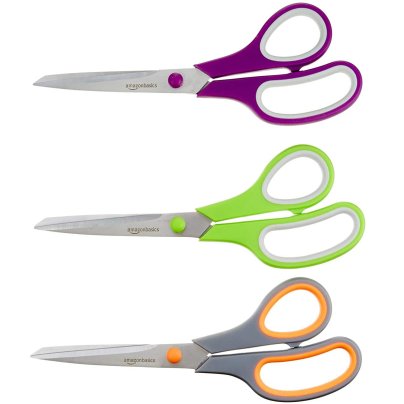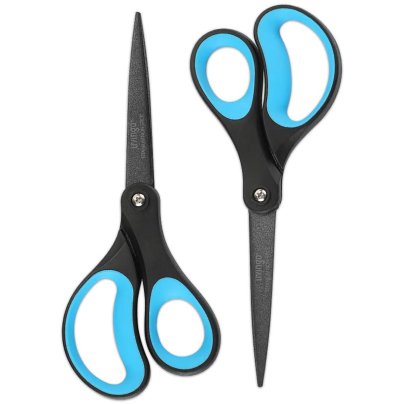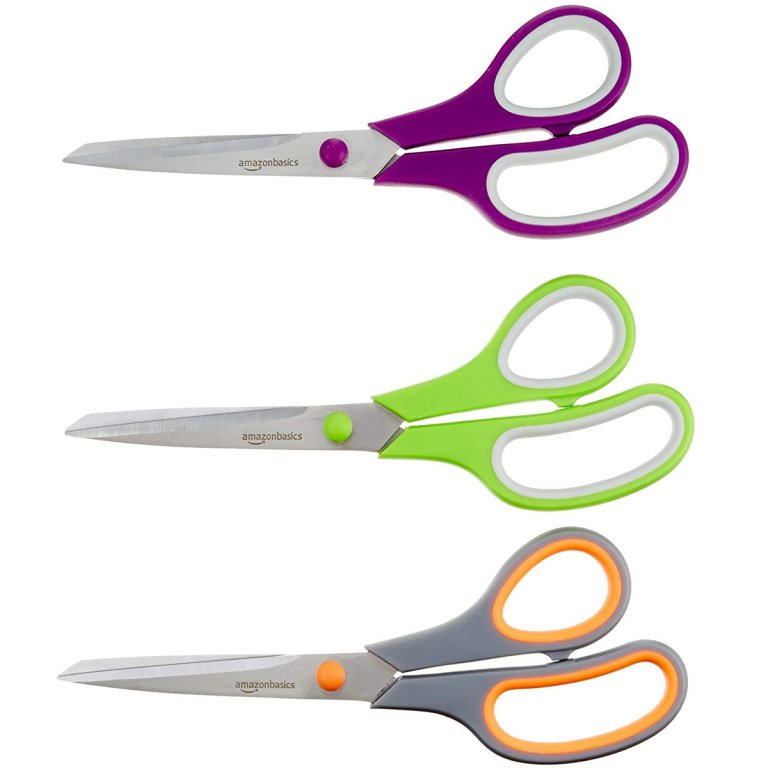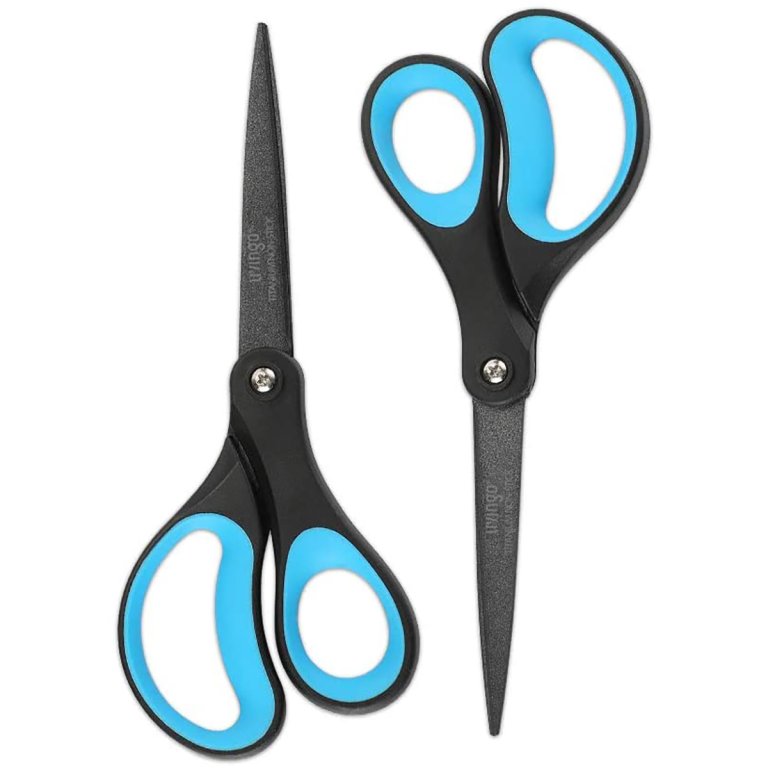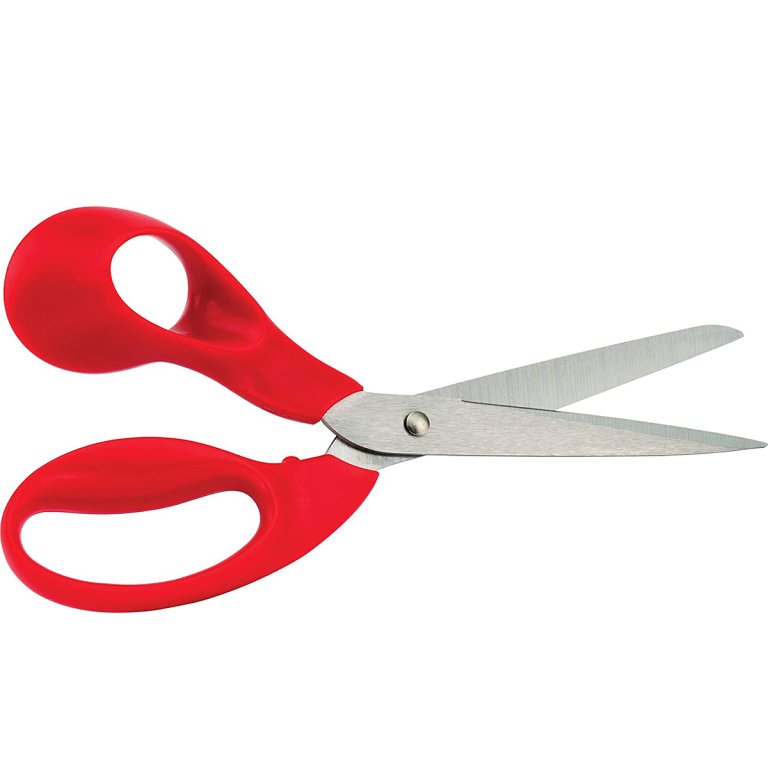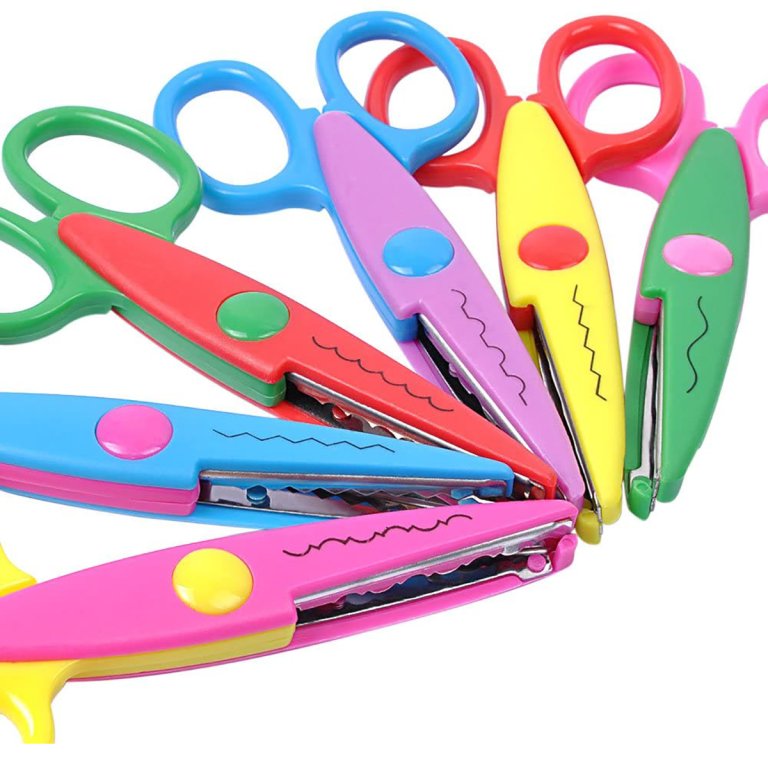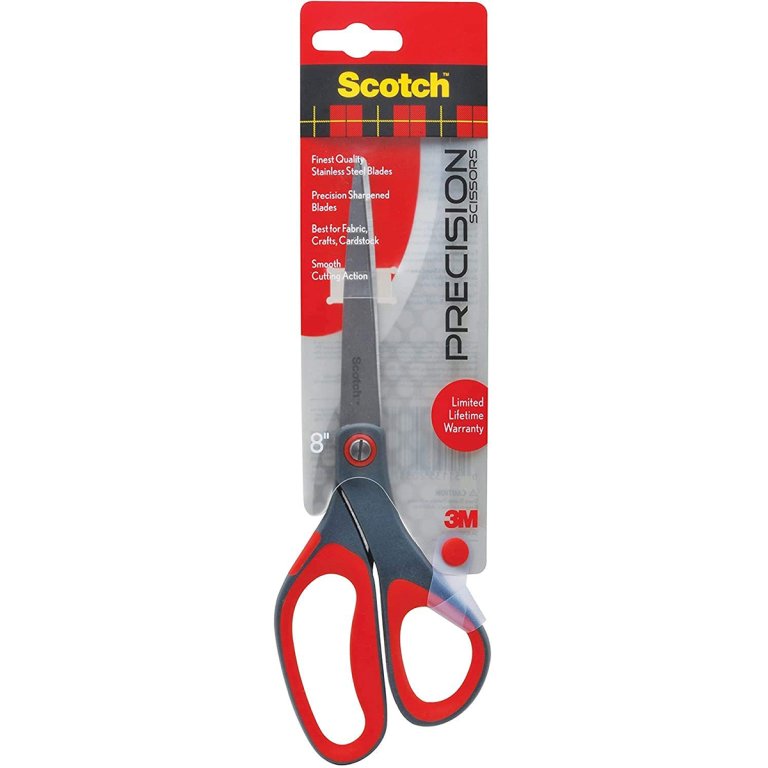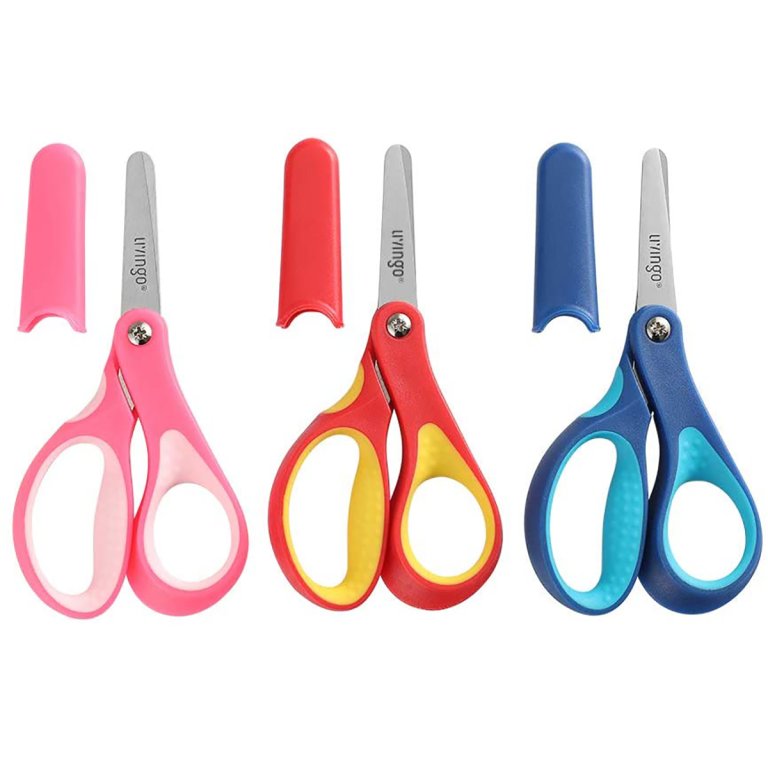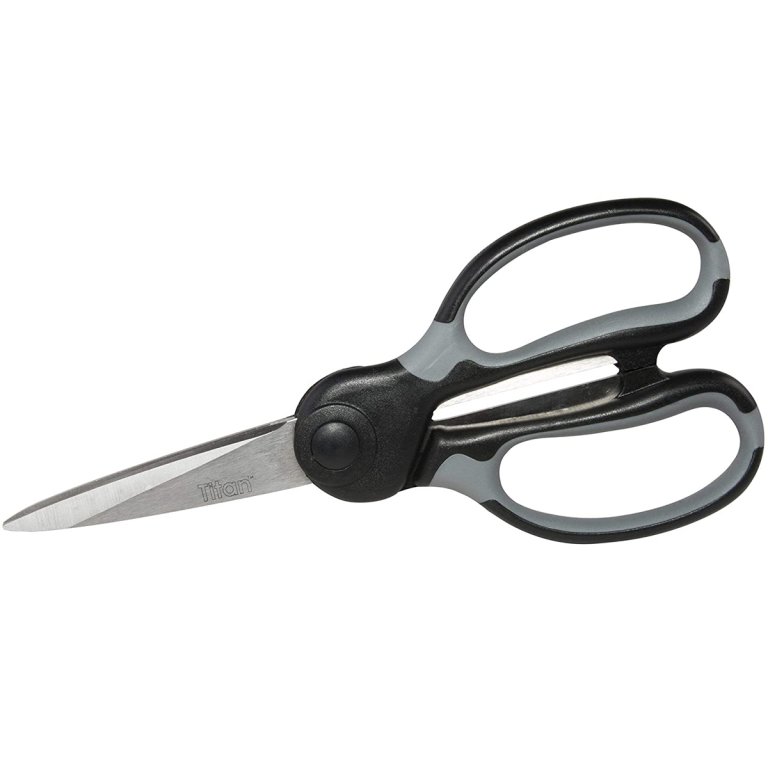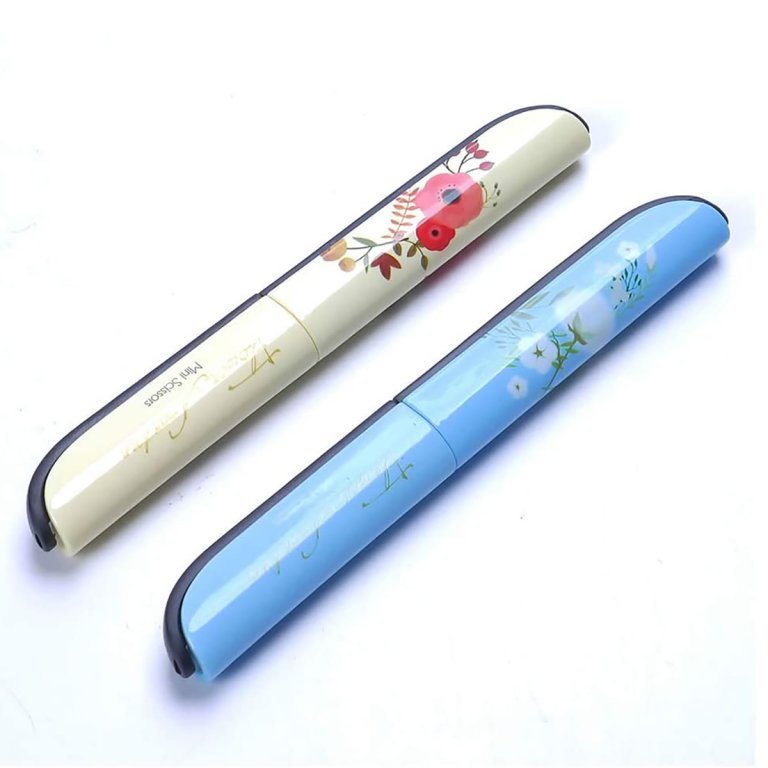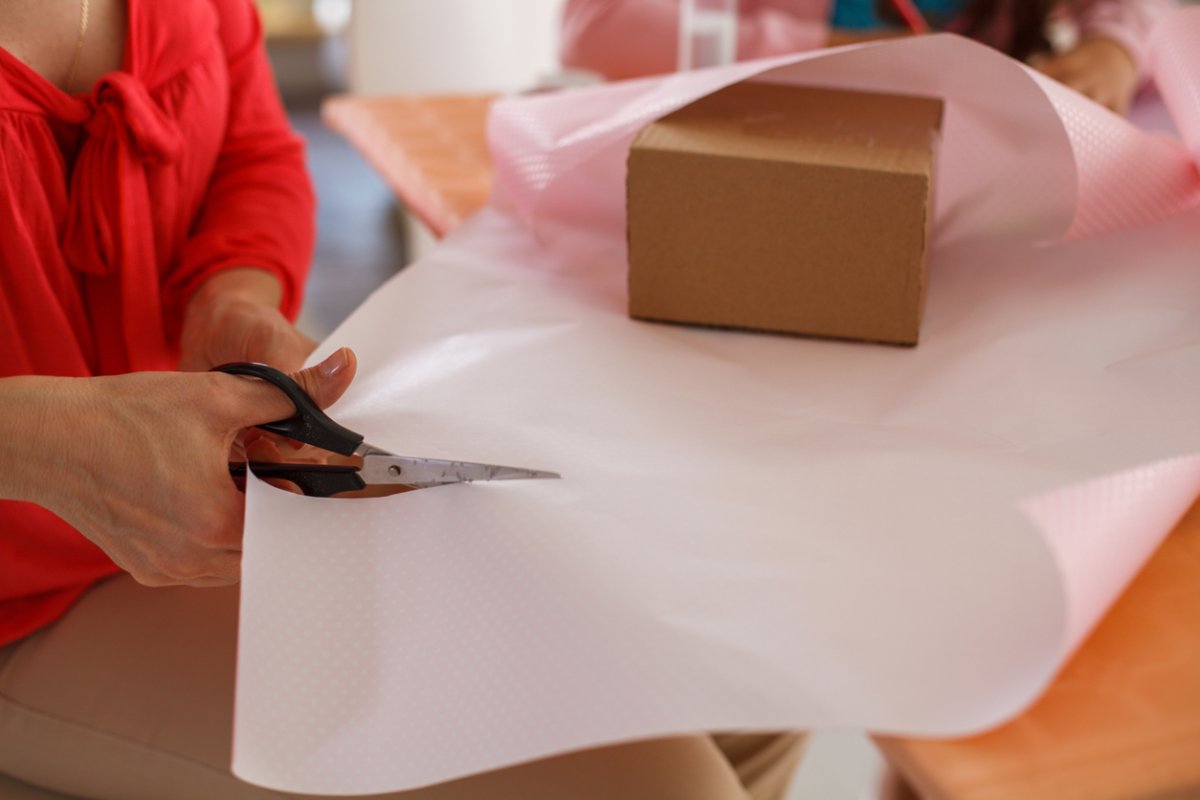
We may earn revenue from the products available on this page and participate in affiliate programs. Learn More ›
Believe it or not, scissors are one of the most important tools in your home. Although scissors can be used to cut a number of thin materials, including cardboard, foil, fabric, rope, and even wire, they’re most often used to cut paper.
Finding the best scissors for your home depends on whether you’re right- or left-handed, the size and comfort of the grip, and the type of material you’ll be cutting. Safety features are also important, especially if you have kids. To help you select the perfect pair, start with this shopping advice and curated list of some of the best scissors on the market.
- BEST OVERALL: AmazonBasics Multipurpose, Comfort Grip, Titanium
- BEST BANG FOR THE BUCK: BambooMN Titanium Softgrip Scissors Set for Crafts
- BEST COMFORT GRIP: LIVINGO 2 Pack 8″ Titanium Scissors
- BEST LEFT-HANDED SCISSORS: Maped Expert Scissors, Adult, 8.25 Inch, Left Handed
- BEST DECORATIVE SCISSORS: UCEC 6 Colorful Decorative Paper Edge Scissor Set
- BEST FRINGE SCISSORS: SourceTon 2 Packs Stainless Steel Herb Scissors
- BEST PRECISION SCISSORS: Scotch Precision Scissor, 8-Inches, Grey/Red
- BEST SAFETY SCISSORS: LIVINGO 5″ Small School Student Blunt Tip Scissors
- BEST HEAVY-DUTY SCISSORS: Titan Elite Industrial Grade Heavy Duty Scissor
- BEST FOLDING SCISSORS: RAYNAG Set of 2 Portable Safe Scissor

Common Types of Paper-Cutting Scissors
Scissors, although a seemingly simple tool, come in a variety of shapes and sizes, each designed with a different purpose or task in mind. Some of the most common types of scissors include multipurpose, decorative edge, fringe, precision, safety, heavy-duty, and folding or travel scissors.
Multipurpose Scissors
Multipurpose scissors (also known as all-purpose scissors) have straight, functional blades and comfortable handles, allowing you to use them for whatever random household tasks may come up. As the name suggests, multipurpose scissors are versatile in use—they’re ideal for cutting printer paper, construction paper, wrapping paper, and even cardboard. Because of their frequent use, however, you may need to sharpen the blade every now and again, depending on what you’re cutting.
Decorative Edge Scissors
Decorative edge scissors are designed to do exactly that: add a decorative edge to your paper. Decorative edge scissors are great for art projects, poster design, homemade cards, or anything else where a decorative edge will add a pop of creativity you can take pride in. These scissors are designed with different cutting patterns including zigzag, scallop, and waves so you can switch between cut patterns or use them collaboratively to create a fun and interesting design.
Fringe Scissors
Fringe scissors are perfect for scrapbookers and avid crafters. These special scissors can be easily identified by their five blades that are used to make quick, even cuts. Fringe scissors can be used to make paper confetti or to shred paper for decorative purposes. In the kitchen, these scissors may be referred to as “herb scissors” because they’re great for cutting herbs into very small portions for cooking or drying.
Precision Scissors
Precision scissors look similar to multipurpose scissors; however, the blades are narrower and feature a pointed tip. The narrow profile and focused grip help careful crafters make clean, precise cuts to form shapes or intricate designs. Precision scissors are usually made from high-quality material, like titanium, that holds its edge and cleanly cuts through paper and other materials.
Safety Scissors
Safety scissors (also referred to as children’s scissors) are designed with a blunted end and dull blades to prevent accidents. They’re also small in size, making them the perfect tool for little hands to cut wet spaghetti or play dough. Some safety scissors have plastic shielding around the blades and over the handles to further prevent users from accidentally harming themselves.
Heavy-Duty Scissors
While heavy-duty scissors have a similar appearance to multipurpose scissors, they are thicker both blade- and handle-wise, as they’re designed to cut through foam, cork, thick cardboard, and even some types of wood and metal. While these scissors are not particularly useful for thin pieces of paper, they can cut through a small stack of paper or even a small stack of cardboard.
Folding/Travel Scissors
Folding scissors or travel scissors are a compact version of traditional scissors that allow you to fold the blade into the handle for safe transportation. These scissors can be found in a variety of folding forms. In fact, some folding scissors are designed intricately enough to transform into the shape and size of a standard pen. The only downside? These scissors aren’t exactly comfortable because they’re designed for portability and not long term use.
Shopping Considerations
Before buying a new pair of scissors, there are a few things you should consider, including the purpose, size, and sharpness of the blade.
Purpose
It’s basically impossible to choose the perfect pair of scissors if you’re unsure of what you need them for. Before diving into your browsing session, take a second to think about the specific project you’ll be working on.
Ask yourself: What type of paper will I be cutting? Will I need to make intricate or hard-to-replicate shapes? Will the kids be helping? Heavy-duty scissors, for example, are great for cutting cardboard and foil, whereas fringe scissors can be used to make paper confetti or holiday decorations. Ultimately, the type of scissors you choose to buy will depend on the project.
Size
Scissors come in a number of shapes and sizes ranging from small folding scissors to bulky heavy-duty scissors. Here’s a size guide by type of scissors.
- Multipurpose scissors come in a variety of lengths and weights. These versatile scissors are around 8 inches long (that’s larger than most common household scissors).
- Decorative edge scissors come in a range of sizes, but these scissors normally measure the same length as precision scissors.
- Fringe scissors are usually shorter in length than precision scissors, but they’re designed with five blades instead of the usual two. For this reason, they can be bulkier than precision scissors.
- Precision scissors can be short or long in length, but the blades are narrow. This is so you can make precise, clean cuts.
- Safety scissors are smaller than traditional scissors. This is because they’re typically used by children.
- Heavy-duty scissors are the largest household scissors you can buy. The blades and handles are thick so that increased power can be transferred from your hands through the blades, allowing them to cut through thick materials, like cardboard, or stacks of paper.
- Folding scissors are small and utilitarian. Folding scissors are best used for emergencies or wardrobe malfunctions, as they’re small, lightweight, and a bit uncomfortable to use for long periods of time.
Blades
Most household scissors are shaped one of two ways: two straight blades or one straight blade and one rounded blade. A rounded blade gives you the ability to cut without expending too much force. A straight blade, however, is better for a more accurate cut, as it can be difficult to line up a rounded blade.
Scissor blades also come coated. Some coating options include fluorine, titanium, or uncoated stainless steel. Fluorine-coated blades are best for cutting stickers, tape, and other sticky materials, while titanium coating is best for cutting thicker materials. Basic paper-cutting scissors are usually made with uncoated stainless steel blades. These are inexpensive but offer no extra benefit.
Handle and Grip
The handle and grip on a pair of scissors can be made with metal, plastic, or rubber. Softer materials are easier on the hands, allowing you to use the scissors for a longer period of time, but a firm handle gives better precision control.
If you have any muscle-weakening conditions, it would be beneficial to find scissors with ergonomic handles. You should also look for a pair of scissors that fit comfortably in your dominant hand.
- Right-handed scissors are designed so that the blade on the right moves up and the blade on the left moves down when opened.
- Left-handed scissors position the top blade on the left. This way, the cutting line is always visible.
Versatility
The versatility of a pair of scissors can be determined by the type of blade, the size of the scissors, and their performance in specific situations. Small scissors, such as folding scissors and safety scissors, for example, can become uncomfortable for adults to use for long periods of time. This limits their use to emergencies, unique utility purposes, and children’s crafts. Scissors that have unique blades, such as decorative edge and fringe scissors, are useful only in specific instances, like when you’re making confetti or adding a design to the edge of the paper.
Other scissor types, such as precision scissors and heavy-duty scissors, are limited by the size and shape of their blades. The narrow profile of precision scissors is great for small, exact cuts, but it isn’t effective with bulkier material. The reverse is true of heavy-duty scissors.
Multipurpose scissors are the most versatile type of scissors (hence the name), with the most useful blade size and shape for the widest variety of purposes.
Safety
Scissors with pointed tips, sharpened blades, and even a possible finger pinch point between the handles can be very dangerous. To keep you and your kids safe, look for scissors that were built with safety in mind. Safety features can include rounded blade tips, dulled blades, blade sheaths, or plastic blade guards.
- Rounded blade tips are commonly seen on safety scissors and medical scissors. This tip shape is intended to protect users and patients from getting accidentally jabbed with a pointed tip.
- Dulled blades do not prevent you from cutting yourself, but the dullness does make it more difficult. This safety feature is normally present in safety scissors.
- Blade sheaths are protective covers that can be placed over the blades of your scissors when they’re not in use.
- Plastic blade guards are a distinct feature of safety scissors. These guards can help protect you from unintentionally harming yourself. Unlike blade sheaths, blade guards fit over the blades, leaving only the edge of the blades exposed to cut paper.
Our Top Picks
Now that you’re all caught up on scissor type and safety, you can begin shopping. This guide rounds up several pairs—recommended by their quality and price—to help you select some of the best scissors for your household.
Best Overall
AmazonBasics Multipurpose, Comfort Grip, Titanium
Ensure that you’re prepared to tackle craft projects with a pack of AmazonBasics Multipurpose Scissors. Made with titanium-fused blades, these scissors are built to retain their edge, so you won’t have to sharpen them as often as you would stainless steel blades. They can be used for cutting paper, cardboard, fabric, photo paper, and a wide variety of other materials.
These multipurpose scissors come in a pack of three, with each pair of scissors measuring 8.3 inches long. The handles are designed with soft-grip padding on the inside of the finger holes so that you can use them for a longer period of time without experiencing hand fatigue. These scissors do not, however, have safety features that would make them appropriate for children.
Best Bang for the Buck
BambooMN Titanium Softgrip Scissors Set for Crafts
Having a pair of scissors around the home is always a good idea, but it can be more beneficial to have a set of three that range in size so that you can take on a wider variety of household tasks. These inexpensive scissors have soft handle grips for comfortable use and titanium-fused blades that have a reflective rainbow design.
This set of scissors includes a pair of 10-inch dressmaking scissors that are great for cutting cloth or rags. You also get a pair of 8.5-inch multipurpose scissors that can be used to cut cardboard for recycling. The third pair of scissors is a pair of 5.5-inch embroidery scissors that can be used to cut stray threads from your clothing instead of pulling the thread and potentially damaging the material.
Best Comfort Grip
LIVINGO 2 Pack 8" Titanium Scissors
Using scissors for a quick household task isn’t going to cause your hands to cramp up, but if you’re wrapping presents, working on a project, or doing arts and crafts with the kids, using uncomfortable scissors can quickly lead to hand fatigue. This two-pack of multipurpose scissors is designed with an ergonomic handle and a comfort grip that reduces pressure on your fingers when you close the scissors.
These multipurpose scissors measure 8 inches in length and have titanium blades that are built to last. They also have a Teflon nonstick coating. This nonstick coating makes these scissors great for cutting tape, stickers, and other adhesive materials that would otherwise create a residue on regular blades.
Best Left-Handed Scissors
Maped Expert Scissors, Adult, 8.25 Inch, Left Handed
Using right-handed scissors can leave left-handed individuals with sore hand muscles and calluses. To prevent this from happening, you can get this left-handed pair of multipurpose scissors that features unique left-handed grips on the handles.
These scissors are suitable for cutting paper in the office, cutting cardboard at home for recycling, or even for cutting fabric, although you should ensure the blades are sharp enough before cutting fabric to prevent tearing. They measure 8.25 inches in length and come with stainless steel blades that are dishwasher safe, allowing you to quickly clean them along with your dishes.
Best Decorative Scissors
UCEC 6 Colorful Decorative Paper Edge Scissor Set
Thanks to the rounded tips and protective plastic covering, this set of scissors is ideal for a craft night with the kids. Each pair of scissors included in this pack has its own unique cutting pattern, including scallops, zigzags, and waves, allowing you to choose between multiple patterns for your project.
The scissors are only 5 inches in length, but the handles are designed with same-size finger holes so that they can be used in either the up or down position without affecting your grip. While these scissors aren’t exactly useful elsewhere in the house, they’re perfect for creating patterns and designs for homemade cards, scrapbook pages, photos, gifts tags, and other decorative projects.
Best Fringe Scissors
SourceTon 2 Packs Stainless Steel Herb Scissors
Fringe scissors typically serve a specific purpose to cut fringes in fabric, but you can also use fringe scissors, like this two-pack of stainless steel fringe scissors, to cut paper into even strips, shred paper, or create confetti. You can even use them in the kitchen to make small, precise cuts through herbs for cooking.
These scissors measure 8 inches in length and can be used comfortably by both right- and left-handed people. The blades are made of stainless steel, and the manufacturer notes that the scissors are dishwasher safe, allowing for a quick cleanup. You also get a long-finger cleaning brush that can be used to clean between the blades of the scissors.
Best Precision Scissors
Scotch Precision Scissor, 8-Inches, Grey/Red
Precision scissors are a necessity if you want to cut sharp corners or tight angles into heavyweight paper or photos. With these 8.8-inch precision scissors, you can also cut through fabrics. What’s more, they’re equipped with stainless steel blades that have a pointed tip and a narrow profile so that you can easily maneuver your way through while you cut, without damaging the material around the scissors.
The blades of these precision scissors come machine sharpened so you can use them immediately after opening. The handles are suitable for right-handed individuals, and they feature a comfort grip to help reduce hand fatigue. While the design of precision scissors makes them ideal for exact cutting, the pointed tip, narrow blade profile, and machine-sharpened edges can be very dangerous, so they are not considered safe for children to use.
Best Safety Scissors
LIVINGO 5" Small School Student Blunt Tip Scissors
Children can have a great time with arts and crafts at home, but it’s important that they stay safe while having fun. These safety scissors come with comfort-grip handles that are soft and easy to grasp. The finger holes are made small enough for toddlers to use, and they come with a textured surface to help prevent the scissors from slipping. This three-pack of scissors also comes with three different handle colors so they can be shared evenly among your children.
These safety scissors are 5 inches long and end in a blunt tip to ensure an accident-free craft night. When the scissors aren’t being used, a plastic blade sheath protects the blades from nicks and damage—and your kids from accidental cuts.
Note: While these are safety scissors, your children should be supervised when using them.
Best Heavy-Duty Scissors
Titan Elite Industrial Grade Heavy Duty Scissor
These heavy-duty, commercial-grade scissors are strong enough to shred rags, cut stacks of paper, and slice long electrical wiring into small enough pieces for proper recycling. They’re 8 inches in length, and the blades are made of sharpened stainless steel that have been heat tempered to retain the sharp edge.
But these scissors aren’t just sharp; they’re guaranteed to last with a lifetime warranty. In addition, the handles have an ergonomic comfort grip which makes them easy to use, even when cutting up to 20 layers of poly/cotton fabric, 20 sheets of paper, or up to 10 sheets of cardboard.
Best Folding Scissors
RAYNAG Set of 2 Portable Safe Scissor
Keeping a pair of scissors with you when you leave the house is a good way to ensure that you’re ready to handle the unexpected. This two-pack of folding scissors has a compact design that can fold up into the same shape and size as a regular pen, making it easy to take your scissors with you when you go out.
The handles are made of durable ABS plastic that features an attractive design, and the blades are made of high-carbon steel so you can count on them to be sharp. These scissors are 5.4 inches long, and they have a safety cap and lock that keeps the blades safely secured when the scissors are not in use.
FAQs About Scissors
Continue reading below to find the answers to some of the most commonly asked questions about scissors.
Q. What is the proper way to hold scissors?
The proper way to hold scissors is to grip the scissors in your dominant hand, with your thumb through the smaller hole on the handle and your index and middle fingers through the larger hole on the handle. You can put your other fingers in this second handle hole if there is space, but you don’t need to in order to use the scissors.
Your thumb and fingers pull apart from each other to open the scissors, then push toward each other in a pincer movement to close the scissors. With these simple movements, you can cut paper.
Q. Can you use fabric scissors on paper?
You can use fabric scissors on paper, but the paper will quickly dull the blades of these scissors.
Q. What is the best way to sharpen scissors?
The best way to sharpen a pair of scissors is by using a sharpening stone with a coarse grit surface and a fine grit surface for best results.
Q. Can you put scissors in the dishwasher?
It depends on the type of scissors and the material used in their construction. A pair of kitchen scissors with plastic handles and stainless steel blades is safe to clean in the dishwasher.
